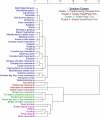Cluster analysis of the Yale Global Tic Severity Scale (YGTSS): symptom dimensions and clinical correlates in an outpatient youth sample
- PMID: 20386987
- PMCID: PMC2902733
- DOI: 10.1007/s10802-010-9410-5
Cluster analysis of the Yale Global Tic Severity Scale (YGTSS): symptom dimensions and clinical correlates in an outpatient youth sample
Abstract
Tic disorders are heterogeneous, with symptoms varying widely both within and across patients. Exploration of symptom clusters may aid in the identification of symptom dimensions of empirical and treatment import. This article presents the results of two studies investigating tic symptom clusters using a sample of 99 youth (M age = 10.7, 81% male, 77% Caucasian) diagnosed with a primary tic disorder (Tourette's disorder or chronic tic disorder), across two university-based outpatient clinics specializing in tic and related disorders. In Study 1, a cluster analysis of the Yale Global Tic Severity Scale (YGTSS) identified four symptom dimensions: predominantly complex tics; simple head/face tics; simple body tics; and simple vocal/facial tics. In Study 2, these clusters were shown to be differentially associated with demographic and clinical characteristics. Findings lend support to prior research on tic phenomenology, help to organize treatment goals, and suggest symptom dimensions of tic disorders for further evaluation.
Figures


Similar articles
-
A cluster analysis of tic symptoms in children and adults with Tourette syndrome: clinical correlates and treatment outcome.Psychiatry Res. 2013 Dec 30;210(3):1198-204. doi: 10.1016/j.psychres.2013.09.021. Epub 2013 Sep 27. Psychiatry Res. 2013. PMID: 24144615 Free PMC article. Clinical Trial.
-
A multicenter examination and strategic revisions of the Yale Global Tic Severity Scale.Neurology. 2018 May 8;90(19):e1711-e1719. doi: 10.1212/WNL.0000000000005474. Epub 2018 Apr 13. Neurology. 2018. PMID: 29653992 Free PMC article.
-
Differentiating tic-related from non-tic-related impairment in children with persistent tic disorders.Compr Psychiatry. 2018 Nov;87:38-45. doi: 10.1016/j.comppsych.2018.07.017. Epub 2018 Aug 25. Compr Psychiatry. 2018. PMID: 30195099 Free PMC article.
-
Tic disorders and Tourette's syndrome.Eur Child Adolesc Psychiatry. 2013 Feb;22 Suppl 1:S55-60. doi: 10.1007/s00787-012-0362-x. Eur Child Adolesc Psychiatry. 2013. PMID: 23224240 Review.
-
Is it a tic or Tourette's? Clues for differentiating simple from more complex tic disorders.Postgrad Med. 2000 Oct;108(5):175-6, 179-82. doi: 10.3810/pgm.2000.10.1257. Postgrad Med. 2000. PMID: 11043089 Review.
Cited by
-
An Observational Longitudinal Study on Seasonal Variations in Tourette Syndrome: Evidence for a Role of Ambient Temperature in Tic Exacerbation.Biomedicines. 2024 Jul 26;12(8):1668. doi: 10.3390/biomedicines12081668. Biomedicines. 2024. PMID: 39200133 Free PMC article.
-
Economic evaluation of deep-brain stimulation for Tourette's syndrome: an initial exploration.J Neurol. 2019 Dec;266(12):2997-3008. doi: 10.1007/s00415-019-09521-8. Epub 2019 Sep 4. J Neurol. 2019. PMID: 31485722
-
The Sapap3-/- mouse reconsidered as a comorbid model expressing a spectrum of pathological repetitive behaviours.Transl Psychiatry. 2023 Jan 30;13(1):26. doi: 10.1038/s41398-023-02323-7. Transl Psychiatry. 2023. PMID: 36717540 Free PMC article.
-
Systematic review of severity scales and screening instruments for tics: Critique and recommendations.Mov Disord. 2017 Mar;32(3):467-473. doi: 10.1002/mds.26891. Epub 2017 Jan 10. Mov Disord. 2017. PMID: 28071825 Free PMC article.
-
Allergic diseases influence symptom severity and T lymphocyte subgroups of children with tic disorders.J Investig Med. 2021 Dec;69(8):1453-1457. doi: 10.1136/jim-2021-001788. Epub 2021 Jul 13. J Investig Med. 2021. PMID: 34257142 Free PMC article.
References
-
- Achenbach TM. Manual for the child behavior checklist/4-18 and 1991 child profile. Burlington: University of Vermont Department of Psychiatry; 1991.
-
- Achenbach TM, Rescorla L. Manual for the ASEBA school-age forms and profiles. Burlington: Research Center for Children, Youth, and Families; 2001.
-
- American Psychiatric Association . Diagnostic and statistical manual of mental disorders. 4. Washington: American Psychiatric Association; 2000.

